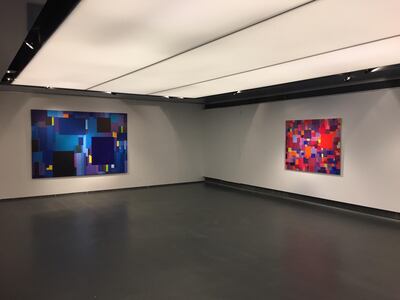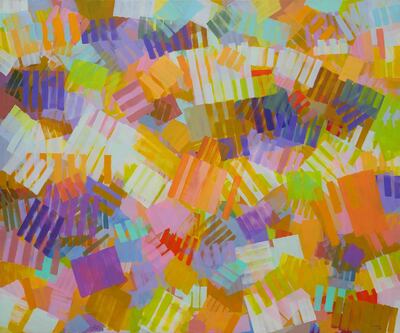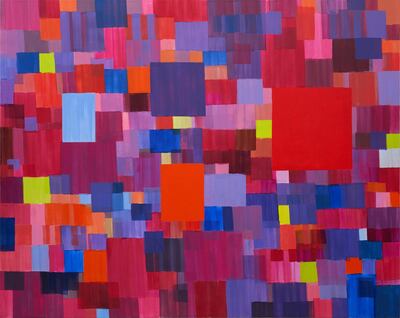For people who enjoy figurative art, abstraction can seem inaccessible. It’s often mischaracterised as an art form that ignores or rejects the concrete realism of landscape and object in favour of pure aesthetics. The work of Samia Halaby belies that perception.
For almost 60 years, the 81-year-old Palestinian artist has experimented with colour, form and texture to create works that examine both physical and intangible aspects of the natural world, rejecting the specificity of detail in an attempt to capture the pure essence of a leaf or the irregular way that light breaks up the uniformity of a darkened city.
Forging personal connections with the viewer
In Opacity and Transparency, her latest solo exhibition, which opened on Tuesday at Ayyam Gallery in Beirut, she continues a long, experimental study of light and how it shapes perceptions of space, time and distance. Contrasting opaque, hard-edged shapes with translucent washes, broken brushstrokes and soft-edged forms, she explores density and depth in vivid colours and subtle variations of shade.

Her abstract acrylic paintings evoke a sense of familiarity, forging personal connections with each viewer. Where one person sees red sparks smouldering in the shadowy blues of a heap of charred logs, another might see sunlight reflecting off a glass skyscraper. A palette of pale yellow, gold and sky blue might recall patterns of sunshine and shade on a field of ripe wheat, or hands running through the thick, tawny fur of a golden retriever.
“Lots of critics would like to say that abstraction comes only from the mind of the artist,” she says. “But everything we see is what gets translated into painting … we look at natural processes and allow them to affect us and our mind processes all the things we see and we extract principles from that … If we use those principles to guide how, we make shape on a painting, then we’re imitating nature not by looking at it from one point of view, like a camera, but from the point of view of a process of thought.
“People will come to a painting and they’ll recognise something in it. It’s not an automobile or a surface, but something in them will say, ‘You’ve seen something like that before’ … That’s a very important act of recognition.”
Shaping her perception of the world
Halaby’s work is the product of a mind used to closely observing and analysing the world around her and has its roots in decades of experience. In Beirut, she finds herself feeling as though she is coming home, she says. Born in Jerusalem in 1936, Halaby fled Palestine with her family in 1948 and spent three years living in Lebanon. In 1951, they emigrated to America, where she has lived ever since. Even as a child, she seems to have been unusually attuned to light and colour. Her family travelled from Lebanon to America by boat, stopping at lots of cities along the way.

“When we arrived in New York it struck me as being a novelty because it was a brown city. I called my sister, ‘Come, come! We’re coming to a brown city.’ Most cities are white when you see them from the Mediterranean,” she recalls, laughing. “Light is very important – and good for our health. When I travel here I always feel better.”
After studying art at Indiana University, Halaby spent several decades as an academic, teaching in Hawaii and serving as the first full-time female associate professor at the Yale School of Art, where she worked for 10 years. Each place she has lived has fed into her artwork, she says, but her early years in Palestine and Lebanon had a lasting impact. "My perception of the world is really formed by these years and by the tragedy in Palestine, which continues day in and day out and continues to deepen," she says. "In visual terms, what you see all the time affects you … The visual things I experienced – like all children, those things are deeply imprinted in your memory."
As well as being hailed as one of the leading pioneers of abstraction, Halaby is known for her political activism in support of the Palestinian cause, in particular her 2002 survey Liberation Art of Palestine and her series of drawings of the Kaft Qasem massacre.
A connection with nature
When it comes to her abstract paintings, however, she sets aside politics and identity in search of a universal language. The examples she gives of the sights that inspire her work are overwhelmingly connected with nature and natural processes. One of her earliest experimentations with abstract painting was inspired by the beauty of autumn leaves.

“I wanted to make a painting from them and nothing I tried worked,” she explains. “In the end I decided the leaf was a visual stage in a whole process of stages, from being a tiny green bud, to a leaf, to being eaten by worms and turned orange by the sun and crumbling, eventually becoming earth. Here was something that was beautiful because of the process of growth. So I decided, ‘If I dare to be as beautiful as nature, let’s see if I can make a painting grow like nature grows.’”
The natural landscape of Hawaii also fed her love of colour and form. “I have sketchbooks full of some of the natural things I saw. Seeds of trees were particularly gorgeous and sumptuous,” she says.
Decades on, her approach to abstraction remains rooted in the idea of stripping away detail to uncover the essential heart of her subject, whether the play of light through a canopy of leaves or a city at dusk.
____________________
Read more:
From humble beginnings: this Palestinian museum in the US has big ambitions
What does the Abraaj sale tell us about the Arab art market?
How Sheikha Hoor Al Qasimi brought new life to Sharjah's arts scene
____________________
Even in her eighties Halaby continues to experiment. In Opacity and Transparency, she returned to techniques she had studied decades ago but never employed, creating translucent washes of colour and using a dry brush to make broad, inconsistent strokes of paint, allowing the colours beneath to show through.
“I think that these were more about light, luminosity – thinking of something dark, like a rock face, but that has jewels in it that are luminous,” she says. “In a big city there are dark buildings, but you always see little titbits of light far away or through the windows … But other things look like that. Abstraction is not about specifics. It can be anything you see that has that quality.”
Opacity and Transparency is at Ayyam Gallery in Beirut until November 30





